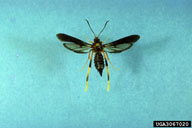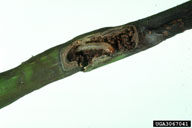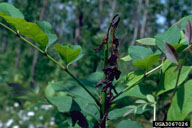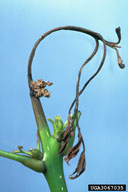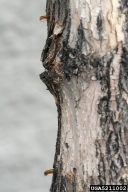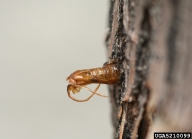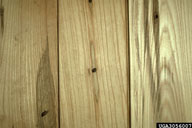Banded ash clearwing
Podosesia aureocincta Purrington and Nielson, and ash/lilac clearwing, Podosesia syringae (Harris) (Lepidoptera: Sesiidae)
Orientation to pest
Banded ash clearwing, Podosesia aureocincta Purrington and Nielson, and the ash /lilac borer Podosesia syringae (Harris), are similar native North American clearwing moths with overlapping host ranges. Podosesia syringae attacks lilac (Syringa), ash (Fraxinus), privet (Ligustrum) and other trees and shrubs. Podosesia aureocincta breeds solely in ash, principally green ash (Fraxinus pennsylvanica Marshall) and white ash (Fraxinus americana L.). Before 1975, P. aureocincta was thought to be a subspecies or just a late brood of the ash/lilac borer emerging from September to December. Adults of P. aureocincta can be recognized and separated from P. syringae by the presence of a narrow orange-yellow partial band on the fourth abdominal segment. The larvae of P. aureocincta can be distinguished from those of P. syringae because P. aureocincta larvae have fewer crochets on their abdominal prolegs (12 to 16 per row vs. 16 to 20 per row for P. syringae). The life histories of these two species are similar. In both, females lay eggs in cracks on the bark of ash (or for P. syringae, various hosts). Larvae tunnel through the wood but continue to expel sawdust and frass, which accumulates around the gallery opening from which the moth will eventually emerge. The overwintering stage in both species is the partly grown larva, which becomes active in spring. Pupation occurs at the end of the larval gallery. Adults of banded ash clearwing emerge later in the year (September-December) than those of P. syringae. There is only one generation of P. syringae per year. Both species cause damage in forest trees and landscape or nursery trees. The damage caused to ash by either species, however, is negligible compared to that from the invasive emerald ash borer, Agrilus planipennis Fairmaire. However, P. aureocincta is regarded as an important timber pest in the southern United States, and in the prairie states both species are damaging to trees in shelterbelts.
Hosts commonly attacked
Podosesia syringae attacks lilac (Syringa), ash (Fraxinus), privet (Ligustrum) and other trees and shrubs, while P. aureocincta breeds principally in green (F. pennsylvanica) and white ash (F. americana).
Distribution
Podosesia syringae occurs more widely than P. aureocincta, being found from Texas to Saskatchewan and east throughout the United States and Canada. Banded ash clearwing, P. aureocincta, is known just from the United States, from New York to Florida and west to Oklahoma. Populations of P. aureocincta are also more scattered than are those of P. syringae.
Images of banded ash clearwing
| Figure 1. Adult of the ash/lilac clearwing, Podosesia syringae; the adult of the closely related species, the banded ash clearwing, Podosesia aureocincta (not shown) is very similar but has a distinctive narrow yellow band around the middle of the abdomen. | Figure 2. Larva of ash /lilac borer, Podosesia syringae, in green ash twig |
| Figure 3. Death of twigs killed by larvae of ash/lilac borer; note frass in photo on right | ||
| Figure 4. Pupal skins of ash/lilac borer left behind on ash trunk following moth emergence | Figure 5. Larval galleries of the ash/lilac borer seen in cross section, in finished ash lumber | |
Important biological control agents related to this pest species
Natural enemies of these clearwings have received little attention. Woodpeckers feed extensively on the immature stages. Several parasitoids have also been reared from them, but their importance has not been assessed. The ichneumonid Phaeogenes ater Cresson and the braconid Macrocentrus marginator (Nees) were reared from P. aureocincta, while the ichneumonid Lissonota sp. was reared from both P. aureocincta and P. syringae. Nematode applications can reduce borer damage in nurseries.
Web links for information on banded ash clearwing
Articles
- McKnight, M. E. and S. Tunnock. 1973. The borer problem in green ash in North Dakota shelterbelts. North Dakota Farm Research 30(5): 8-14
- Purrington, F. F. and D. G. Nielsen. 1979. Genitalic difference between males of Podosesia aureocincta and P. syringae (Lepidoptera: Sesiidae). Annals of the Entomological Society of America 72: 552-555.
- Solomon, J. D. 1983. Lilac borer (Podosesia syringae) discovered causing terminal mortality and resulting forks in young green ash trees. Journal of the Georgia Entomological Society 18: 320-323.
- Purrington, F. F. and D. G. Nielsen. 1987. New host records of parasitic Hymenoptera in clearwing moths (Lepidoptera: Sesiidae). Great Lakes Entomologist 20: 141-142.
- Gill, S., J. Davidson, W. MacLachlan, and W. Potts. 1994. Controlling banded ash clearwing moth borer using entomopathogenic nematodes. Journal of Arboriculture 20: 146-149.
